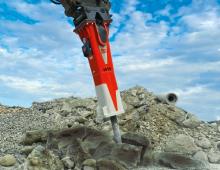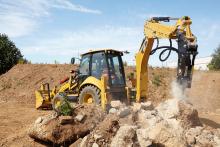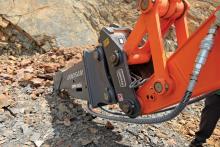
Hydraulic breakers can be used to reduce boulders in the rock pile or on the primary crusher.
Whenever blasted rock is too big to be handled by loading equipment or fed through the crusher, secondary reduction is required, says
“Even with the most advance blasting techniques, it is inevitable that there will be oversize boulders, and these need to be broken as economically as possible,” says the company. It points out that for operations with an output of up to 600,000tonnes/year, feasibility studies should be carried out to show whether the use of heavy-duty hydraulic breakers represent an economic alternative to drilling and blasting.
The company says that hydraulic breakers can be used to reduce boulders in the rock pile or on the primary crusher, while mounting the secondary reduction breaker on a mobile carrier provides a flexible unit with can be used at several points in the quarry.
Indeed, the Middle East`s first Atlas Copco HB 10000 hydraulic breaker was recently commissioned in Saudi Arabia for Eastern Province Cement Company (EPCC) in Dammam.
Weighing 10tonnes, and with a single impact blow energy of 16,000 Joules, which can be released at a rate of up to 380 blows/minute, the HB 10000 has been mounted on a
Atlas Copco says that 16,000 Joules equals a weight force of 760tonnes, more than the landing pressure of an Airbus A380 airplane, repeated 380 times/minute.
The HB 10000 breaker will be used for primary breaking applications in the hard limestone deposits which are arranged in a dam formation in the quarry. The site presents harsh conditions and extreme temperatures, with ambient temperatures reaching up to 51°C.
“The HB 10000 provides an ideal solution for EPCC’s primary quarrying application,” says Fiaz Ghani, regional business line manager at Atlas Copco Construction Tools.
“The combination of extreme power and efficiency provided by the breaker gives real operational savings, making it a cost-effective production machine for primary rock breaking,”
Established in 1982, EPCC is now one of the leading cement companies in Saudi Arabia producing clinker and cement for both local and global markets.
“We are facing very hard rock, which lowers traditional dozer productivity, compared with a hydraulic breaker, in this type of deposit and achieves a lower cost per tonne,” says Shafeek Ahmed, mine superintendent at EPCC
Atlas Copco says that the high power-to-weight ratio and in-built EnergyRecovery feature provided by the HB 10000 makes it an excellent cost-effective option.
“Its lower weight and higher efficiency means less hydraulic input power is required from the carrier, while maintaining maximum impact performance. This allows smaller carriers to be used resulting in significant savings in investment costs. The HB10000 can run on carriers between 85-140tonne weight classes. With less input demanded from the hydraulic system, less fuel is needed by the carrier, which results in further lowering operating costs.”
Italian company
Meanwhile,
“The raised front creates a slightly recessed hole bottom pattern that alters the rock-breaking action in order to
achieve improved performance,” says the company.
“This, together with a new cemented carbide grade GC80, which combines toughness with a softer centre, further extends the service life and long grinding intervals.
To solve the negative effects of over-drilling, Sandvik has developed the Centrex Pro, a down-the-hole drilling system with Spiral Flush that protects sensitive environments and safeguards surrounding structures.
“Forward-moving air collects loose ground or soft clay that settles severely in the surrounding area, putting nearby structures at risk,” says the company.
”The Spiral Flush technology delivers crosswise flushing that causes no pressure against the ground. This means much less risk of over-drilling, and less, or no risk of air escape. Less water is lifted to the surface, which alleviates the risk of disturbing marine deposits.”









